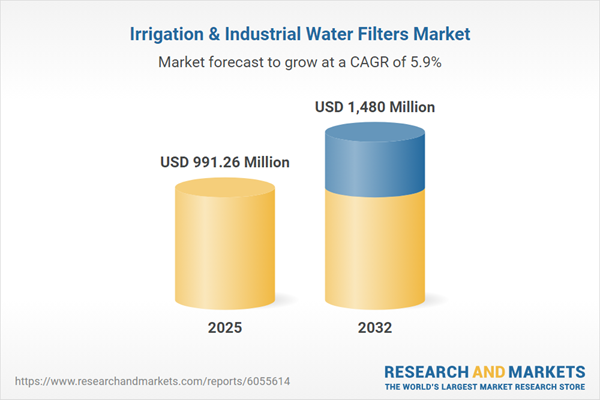Speak directly to the analyst to clarify any post sales queries you may have.
The irrigation and industrial water filters market is rapidly evolving as end users seek advanced solutions to boost resource efficiency, operational reliability, and long-term sustainability. Senior leaders are rethinking water management strategies, focusing on technologies that mitigate risks from water scarcity and regulatory change.
Market Snapshot: Irrigation & Industrial Water Filters Market Growth and Outlook
The irrigation & industrial water filters market grew from USD 937.72 million in 2024 to USD 991.26 million in 2025, and is projected to reach USD 1.48 billion by 2032 at a CAGR of 5.94%. This growth is driven by rising global water stress, intensifying industrial activity, and increasing adoption of digitalization and circular economy principles in water management.
Scope & Segmentation
- Type: Bag Filters, Cartridge Filters, Disc Filters, Magnetic Filters, Media Filters, Reverse Osmosis (RO) Filters, Screen Filters
- Filter Material: Ceramic, Aluminum, Stainless Steel, Polypropylene, PVC
- Flow Rate: High Flow (100-500 M3/H), Low Flow (Less than 10 M3/H), Medium Flow (10-100 M3/H), Ultra-High Flow (More than 500 M3/H)
- Application: Primary Filtration, Secondary Filtration, Tertiary Filtration
- Sales Channel: Offline, Online
- End-use: Chemical Processing, Food & Beverage, Manufacturing, Oil & Gas, Pharmaceuticals, Power Generation, Wastewater Treatment, Center Pivot Irrigation, Drip Irrigation, Flood Irrigation, Micro-Irrigation, Sprinkler Irrigation
- Geographical Coverage: North America (U.S., Canada, Mexico), Latin America (Brazil, Argentina, Chile, Colombia, Peru), Europe (United Kingdom, Germany, France, Russia, Italy, Spain, Netherlands, Sweden, Poland, Switzerland), Middle East (UAE, Saudi Arabia, Qatar, Turkey, Israel), Africa (South Africa, Nigeria, Egypt, Kenya), Asia-Pacific (China, India, Japan, Australia, South Korea, Indonesia, Thailand, Malaysia, Singapore, Taiwan)
- Company Coverage: Includes American Manufacturing Company, Amiad Water Systems, Donaldson, Eaton Corporation, Evoqua Water Technologies, GEA Group, Hennig, Hunter Industries, IDEX, Irritec, Jain Irrigation, Lenntech, Meissner, Mueller, Netafim, Orival, Parker-Hannifin, Pentair, Puretec NZ, Rain Bird, Rivulis Irrigation, SISTEMA AZUD, Sistemas De Filtrado Y Tratamiento De Fluidos, SPX FLOW, Tekleen Automatic Filters, Toro Company, Veolia Water Technologies, WesTech Engineering, Xylem, YAMIT Filtration & Water Treatment
Key Takeaways: Strategic Market Insights for Senior Decision-Makers
- Advanced filtration technologies have become critical to counteract rising water scarcity and meet increasingly strict regulatory standards in both irrigation and industrial settings.
- Market participants are moving toward modular, scalable, and digitalized filtration systems, enabling predictive maintenance, extended asset life, and continuous performance monitoring.
- Material innovation in ceramics, metals, and plastics is addressing diverse operational requirements by enhancing filter durability, increasing chemical compatibility, and supporting cost-efficient operations.
- Procurement trends reveal a shift toward online channels for filter acquisition and maintenance, especially among agile agricultural and mid-sized industrial buyers seeking immediate access and standardized solutions.
- Regional differences are significant: North and South America emphasize retrofits and water reuse in agriculture; EMEA focuses on regulatory alignment and advanced tertiary filtration; while Asia-Pacific leads in industrial expansion and rapid technology adoption through government initiatives.
Tariff Impact: Navigating Cost and Supply Chain Challenges
Recent U.S. tariff measures have significantly affected pricing and sourcing for core filter components. As a result, stakeholders are investing in local manufacturing, vertical integration, and alternative materials, while service models increasingly focus on boosting filter lifecycle value to offset higher capital expenses. Collaborative partnerships and predictive maintenance contracts are becoming standard for mitigating tariff-driven volatility and ensuring business continuity.
Methodology & Data Sources
This report utilizes a robust research framework, integrating primary interviews with industry leaders and procurement officers, in-depth analysis of regulatory and trade association sources, and a cross-validated review of financial disclosures, academic research, and industry literature. Comprehensive segmentation ensures actionable market intelligence at every operational and regional level.
Why This Report Matters
- Enables decision-makers to benchmark technology, material, and procurement choices against evolving market requirements and regulatory environments.
- Delivers a strategic foundation to optimize investments, strengthen supply chains, and build resilience against policy and cost disruptions.
- Supports the development of tailored filtration strategies aligned to specific end-use needs in industrial and agricultural markets.
Conclusion
The irrigation & industrial water filters market offers actionable opportunities for sustainable growth, driven by technological advancement, regulatory change, and supply chain adaptation. Executives equipped with this report's insights can confidently guide their organizations through industry transformation and strengthen operational resilience.
Table of Contents
3. Executive Summary
4. Market Overview
7. Cumulative Impact of Artificial Intelligence 2025
Companies Mentioned
The companies profiled in this Irrigation & Industrial Water Filters market report include:- American Manufacturing Company, Inc.
- Amiad Water Systems Ltd.
- Donaldson Company, Inc.
- Eaton Corporation
- Evoqua Water Technologies LLC
- GEA Group Aktiengesellschaft
- Hennig Inc.
- Hunter Industries, Inc.
- IDEX Corporation
- Irritec S.p.a.
- Jain Irrigation Systems Ltd.
- Lenntech B.V.
- Meissner Corporation
- Mueller Co. LLC
- Netafim Ltd.
- Orival Inc.
- Parker-Hannifin Corporation
- Pentair PLC
- Puretec NZ LP
- Rain Bird Corporation
- Rivulis Irrigation Ltd.
- SISTEMA AZUD, S.A.
- Sistemas De Filtrado Y Tratamiento De Fluidos, S.L.
- SPX FLOW, Inc.
- Tekleen Automatic Filters LLC
- The Toro Company
- Veolia Water Technologies
- WesTech Engineering, LLC
- Xylem Inc.
- YAMIT Filtration & Water Treatment
Table Information
| Report Attribute | Details |
|---|---|
| No. of Pages | 183 |
| Published | November 2025 |
| Forecast Period | 2025 - 2032 |
| Estimated Market Value ( USD | $ 991.26 Million |
| Forecasted Market Value ( USD | $ 1480 Million |
| Compound Annual Growth Rate | 5.9% |
| Regions Covered | Global |
| No. of Companies Mentioned | 31 |









